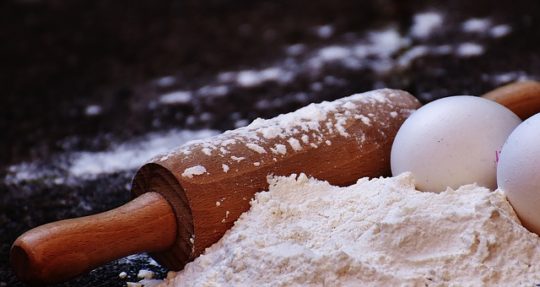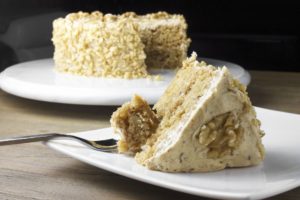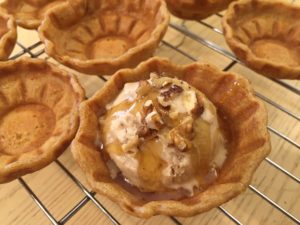*How to Make All Purpose Gluten Free
Flour Blend
One type of gluten-free flour alone cannot replace
the all-purpose white or whole wheat flour used in
regular baking. It is usually necessary to make a
blend of the different weighted gluten-free flours
and starches to replicate the flavor, texture and
density of the gluten-filled flours.
My first choice of a healthy gluten free flour
is using oat flour.
I like to follow these instructions and bottle up
ready-to-use gluten free blend. Oat flour tastes
great as a flour substitute in most baked goods.
It is high in protein, whereas other gluten free
blends are too starchy for health.
An all-purpose gluten-free flour mix that you
can use 1:1 instead of wheat flour in all of
your baking.
Instructions
Measure out and put into a bowl.
1 cup tapioca flour (aka tapioca starch)
1 tsp xanthan gum (optional, but helps it bind)
3 cups of oat flour
OR measure 3-1/4 cups whole or instant oats
into your blender and grind down to the texture of flour.
(This will take about 1 minute depending on the power
of your blender). I use a coffee grinder for excellent results.
Pour the oat flour into a wire mesh strainer or a flour sifter
and sift over a large bowl to (This should be what you
have left after sifting out about 1/4 cup of bran).
Add the tapioca flour and xanthan gum to the oat flour
and stir well until it is well mixed.
Store in an airtight container in the fridge until you are
ready to use it in any baked goods.
Oat Substitutes
You can replace the oats in an oatmeal cookie recipe
with an equal amount of ground flax, rice bran, quinoa
flakes or chia seeds. Ground flax has very little flavor
and is likely to produce cookies that taste similar to the
recipe with oats, with a slightly grittier texture. Rice bran
introduces an earthy tone to the cookies, but they still
taste sweet with a chewy consistency.
Quinoa flakes have a slightly nutty flavor that can enhance
the natural sweetness of oatmeal cookies and give them
a similar texture to oats. Chia seeds have a hardly-noticeable
nutty flavor and create a more crumbly oatmeal cookie.
But when you want lighter results (e.g. angel food cake)
from your gluten free blend, and the starch isn’t a health
concern, mix together 2 cups of oat blend and one cup of
the following blend.
Lighter gluten free flour blends
You can use these blends cup for cup
to replace wheat flour.
RECIPE (for 2 cups)
Gluten Free flour
MIX…
1/2 cup rice flour (white or brown)
1/2 cup potato flour And
1/2 cup oat flour or sorghum+ *1 tsp xanthan gum
1/2 cup cornstarch flour potato starch or tapioca
OR HALF RECIPE (1 cup)
Gluten Free flour
MIX…
¼ cup rice flour (white or brown)
¼ cup potato flour And
¼ cup sorghum flour + *1 tsp xanthan gum
¼ cup tapioca flour potato starch or cornstarch
Can be Mixed with 1¼ cups of oat or other
Gluten Free flour to make 2¼ cups
These quantities can be used when
1½ cups of All Purpose Gluten Free
Flour is called for in a recipe:
½ cup rice flour white or brown
½ cup potato flour
½ cup sorghum, rice, millet or oat flour
+ 1-1/2 tsp *xanthan gum
Plus ½ cup tapioca flour potato starch or cornstarch
Use 1/2 the above for 3/4 cup of flour
1/4 cup rice flour white or brown
1/4 cup potato flour
1/4 cup sorghum, rice, millet or oat flour
+ 1 tsp *xanthan gum
Plus 1/4 cup tapioca flour potato starch or cornstarch
+++++++++++++++++++++++++++++++++
Double the one and a half above for 3 cups
of Gluten Free Flour.
1 cup rice flour white or brown
1 cup potato flour
1 cup sorghum, rice, millet or oat flour
2 tsps *xanthan gum
Plus ½ cup tapioca flour potato starch or cornstarch
+++++++++++++++++++++++++++++++++++++++++++++
If you need 2¼ cups use this recipe below
Can be used as an add-in when a recipe
calls for a portion of other gf flour depending
on your recipe. Such as our Callah recipe
for the Hamotzi Shabbat blessing.
¾ cup rice flour white or brown
¾ cup potato flour
¾ cup sorghum, rice, millet or oat flour
+ 1 tsp xanthan gum
¾ cup tapioca flour potato starch or cornstarch
See half this recipe below

To keep the baked goods from falling apart
you need a binder. My choice is xanthan gum.
You can also use psyllium husk or guar gum.
This is Bob’s Red Mill xanthan gum chart
Cookies………………………………¼ teaspoon per cup of flour
Cakes and Pancakes………………..½ teaspoon per cup of flour
Muffins and Quick Breads………… ¾ teaspoon per cup of flour
Breads……………………………….1 to 1 ½ teaspoons per cup of flour
Pizza Dough…………………..…… 2 teaspoons per cup of flour
The rule of thumb is a 2:1 ratio of flour to starch.
A gluten-free flour blend could be as simple as
1 cup of rice flour for every ½ cup of tapioca starch.
However, too much starch can lead to gummy
results and not a lot of nutrition so it is best to use
flours of different protein contents, weights and
densities.
To make a high-protein flour blend, combine:
1 ¼ cups bean or legume flour (i.e. chickpea, navy bean, soy)
1 cup medium-weight flour (i.e. brown rice, sorghum)
1 cup light starch (i.e. tapioca, cornstarch, potato starch)
If you need to make your flour blend self-rising, add
1 ½ tsp. baking powder and ½ tsp salt for every 1 cup
of gluten-free flour blend.
For substituting flours:
If you are going to substitute a flour choice, match your
flour weight as best you can. Sub a medium weight flour
such as sorghum flour with GF oat flour, or fine brown
rice flour (medium weight to medium weight). Sub a
heavier flour like millet flour with heavier buckwheat.
Sub a light starch such as cornstarch with potato starch
or tapioca starch (starch to starch). Note: Potato starch
rises soft, and tender, while tapioca starch tends to get
a tad tough on its own, though it does brown nicely.
You may wish to combine these two starches to achieve
both softness and a golden crust.
*Maybe you don’t want to buy half a dozen different
flours and gums. Maybe you don’t want to do the math.
You just want to open one bag of flour and start baking.
That’s fine. There are many pre-made gluten-free, all-purpose
flour blends on the market and they have done all the work for you.
Some have more nutritious flours than others.
Read the labels to see which blends use the flours you prefer.
I like my blend to have more high-protein, whole grain flours and
less rice flour.
Also be sure to check whether the blend you buy already has
the xanthan gum added to it.
Some do and some don’t so read those labels.
There are many gluten-free flours available and each has its own characteristics including
protein content, taste, density and weight. The heavier grain flours usually have more protein
and are hearty and nutritious. These might include millet, quinoa, and buckwheat flours, nut
flours and meals, bean and legume flours and cornmeal.
Baking with these is most similar to baking with straight
whole wheat flour resulting in dense,
dark baked goods that don’t rise very much. These are
usually not used alone. At the other end
of the spectrum are the light gluten-free flours. These tend
to be more starchy and include starches
such as tapioca starch (which is the same as tapioca flour),
cornstarch, potato starch (which is not
the same as potato flour) and my favorite starch, arrowroot
powder.
The most commonly used light gluten-free flour is white
rice flour which leads to lighter colored
and less dense texture in baked goods. In the middle are
the flours that give results similar to gluten-filled, all-purpose
flour. These include brown rice flour, oat flour and sorghum flour.
One type of gluten-free flour alone cannot replace the
all-purpose white or whole wheat flour
used in regular baking.
It is usually necessary to make a blend of the different weighted
gluten-free flours and starches to replicate the flavor, texture
and density of the gluten-filled flours.
The rule of thumb is a 2:1 ratio of flour to starch. A gluten-free
flour blend could be as simple as 1 cup of rice flour for every
½ cup of tapioca starch.
However, too much starch can lead to gummy results and
not a lot of nutrition so it is best to use flours of different
protein contents, weights and densities.
To make a high-protein flour blend, combine:
1 ¼ cups bean or legume flour (i.e. chickpea, navy bean, soy)
1 cup medium-weight flour (i.e. brown rice, sorghum)
1 cup light starch (i.e. tapioca, cornstarch, potato starch)
If you need to make your flour blend self-rising, add 1 ½ tsp. baking powder and ½ tsp. salt
for every 1 cup of gluten-free flour blend.
Gluten is what gives baked goods their structure. Without the gluten, foods are more likely to
fall apart. Adding gums such as xanthan gum or guar gum replaces some of that structure.
For yeast products, add 1 teaspoon of xanthan gum or guar gum per cup of flour blend.
For non-yeast products, add ½ teaspoon of xanthan gum or guar gum per cup of flour blend.
Some people avoid gums because of digestive issues or sensitivities. In those cases, adding
psyllium, agar agar, chia seeds or flax seeds in amounts equal to the gums required can also do
the job. In some recipes, you may find you don’t need any gluten-replacers at all.
The more you bake, the more you will learn which of your recipes come out better with the
gums added.
When you need to bake gluten-free, all the rules change.
Gluten-free baking requires different
flour, different techniques and different baking times.
It took me a lot of trial and error but eventually
I learned how to bake delicious gluten-free treats.
Once you understand why you make the substitutions,
it gets much easier. To help you have success
with gluten-free baking, here is my ultimate gluten-free
vegan baking substitution guide.
First, get familiar with all the different gluten-free flours.
Grain flours include amaranth, teff, quinoa,
brown rice, white rice and certified gluten-free oat flour.
Nut flours are nutritious and delicious and they include
almond, hazelnut and peanut flour. Grain-free
and nut-free flours include coconut, chickpea and soy flour.
Some of my favorite choices for baking
are sorghum flour which is slightly sweet, almond and hazelnut
flours which add yummy nutty flavors,
and buckwheat when I want a dense, dark, nutty taste. With
all the choices available, it should be pretty
easy to find flours that meet your dietary needs.
Try baking with different flours to discover which ones
give you the best taste and texture for your recipes.
From https://www.onegreenplanet.org/vegan-food/
the-ultimate-gluten-free-vegan-baking-substitution-guide/






